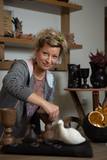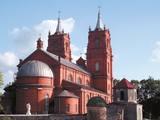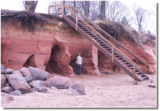| Нo | Название | Описание |
|---|---|---|
|
Atrodas Lubāna dienvidu krastā pie dambja un Īdeņas kanāla, no kura var aplūkot „tipiskas” mitrāju ainavas – niedrājus, aplūstošus krūmājus, mitras pļavas, aizaugušo ezeru. |
||
|
Nepilnus 3 km garā taka iepazīstina ar dziļo Imulas ieleju – Abavas kreisā krasta pieteku. Īpaši iespaidīga ieleja izskatās bezlapu periodā, kad ir apjaušami tās izmēri un formas. Viens no takas iespaidīgākajiem objektiem ir Buses jeb Matkules pilskalns. Apskatāmi citi objekti – Baznīckalns, Bedrīšakmens, Ķauķa kalns ar avotiņu. Atrodas dabas parkā „Abavas senleja”. |
||
|
Музей хлеба, пекарня и гостевой дом, расположенные всего в 0,6 км от Аглонской базилики. Посетители могут проследить путь хлеба от зернышка до буханки, которую каждый может сделать сам. Предлагается дегустация хлеба (и травяные чаи) с театрализованным представлением на крестины, свадьбу, юбилей и др. На стол ставятся клёцки, крапивники, суп из сушеных грибов или уха из речной рыбы. В музее можно приобрести свежеиспеченный хлеб и работы местных ремесленников. Латышская кухня: Суп из озерной рыбы, клёцки и крапавники. Особое блюдо: Суп из сушеных грибов. |
||
|
Roograhu ostas restorāns atrodas tieši jūras krastā un ir atvērts visu gadu. Sortimentā ir picas, gardas zupas, salāti un pamatēdieni. Roograhu ostas restorāna ēdienkartē netrūkst arī vietējo sezonālo zivju. Ostas ēkā darbojas arī viesu māja un kubla pirts ar skatu uz jūru. |
||
|
Одна из редких ремесленников, которые в процессе работы не используют гончарный круг, а работают в технике «улитки» или «колбаски» (подобно тому, как это делали в бронзовом веке), создавая работы, которые отличаются не только разнообразием форм, но и своей функциональностью. Дети могут заниматься в мастер-классах. Экскурсия, открытие печи и приобретение работ окуренной керамики. |
||
|
Наутренский (Роговский) Римско-католический костёл
Непорочного зачатия Девы Марии построен из кирпича в
романском стиле и c двумя высокими башнями (1901 – 1914 гг.)
вместо старого костёла. В 1939 году был приобретен орган –
памятник искусства.
|
||
|
Vieta, ko nekādi nevar uzskatīt par tūrisma objektu, bet tajā pat laikā tas ir Latvijas mērogā nozīmīgs kultūras un vēstures piemineklis, ko nevar nepieminēt! Laikā no 1923. – 1943. gadam muižas pilī atradās Latvijā zināmākā mājturības skola, kurā mācījās izslavētās kaucmindietes! Tagad muižas pils ir pamesta, avārijas stāvoklī un apskatāma tikai no ārpuses un „pa gabalu”. Ap 1780. gadu celtā pils, kas 1909. – 1912. g. tika pārbūvēta pusloka būvapjomā, ir Latvijai diezgan unikāls arhitektūras paraugs. |
||
|
Jēsū – Kepu ceļa malā pie Leti (Läti) ciema ir izveidots autostāvlaukums ar putnu vērošanas torni, no kura paveras skats uz Hallistes upes palieņu pļavām un tuvējā ciema apkārtni. Stipru palu laikā arī no šī torņa redzamā apkārtne (izņemot ceļus) var atrasties zem ūdens. Laba putnu vērošanas vieta. Läti tulkojumā no igauņu valodas nozīmē Latvija. |
||
|
This tour of the Forest Trail covers the national parks of Dzūkija and Žemaitija and the Nemunas Loops Regional Park in Lithuania. The starting point of the route is Druskininkai, a popular SPA and mineral water resort on the banks of the river Nemunas. Here, we recommend dipping yourself in mineral water baths, enjoying the trip with the cable car over the river Nemunas, visiting the musical fountain, and walking along the river promenade. For the next two days from Druskininkai, the Forest Trail passes through the Dzūkija National Park to the town of Merkinė. In this most forested and unpopulated region in Lithuania you can enjoy hiking along solitary forest roads, visit ancient mounds and ethnographic villages, where the traditions of bee-keeping, crafts, mushrooms and berry harvesting are still kept alive. You will then head to Birštonas, one of the key resorts in Lithuania with its valuable mineral waters. The town finds itself in the Nemunas Loops Regional Park, which includes four large and one smaller loops of the river. The Forest Trail stretches from Birštonas through the entire Nemunas Loops Regional Park up till the town of Prienai. Next, hikers will get to Kaunas, the second largest city in Lithuania and its former capital city. Kaunas is notable for its modernist architecture. The catchment area of the river Nemunas and the river Neris is situated here. Heading on, from Lampėdžiai to Vilkija, the Forest Trail runs for two days along trails and small countryside gravel roads next to the right bank of the river Nemunas, also crossing resort territory of Kulautuva. This section is characteristic of beautiful riverscapes, waterfront meadows and small villages. For the final section, first you must get to the Žemaitija National Park, where the Forest Trail runs around the Lake Plateliai, which is the largest lake in the historic Samogitian region. Old pine and fir forests and mixed forests are among the most precious natural values of |
||
|
This territory is Lithuania’s most forested area, and people here have always lived in accordance with nature. Local treasures include berries, mushrooms, honey, clean water from streams and rivers, etc. People here have engaged in various crafts, as well as in beekeeping.
|
||
|
Ainavisks jūras viļņu izskalots smilšakmens atsegums
dienvidos no Zaķupes ietekas.
|
||
|
The campsite is located 77 km from Riga, surrounded by beautiful forest and sea. The range of offers is wide - beach volleyball court, basketball court, windsurfing, table tennis and more. There are tent sites as well as double or quadruple camping houses. There are facilities for people with reduced mobility. The campsite is open from 1 May until 31 October. Large WC and shower room (shared). |
||
|
This park is located in the northern part of the Žemaitija Highlands, and much of it is taken up by Lake Plateliai. The park was established to protect lakes, rivers, wetlands and forest ecosystems, as well as the local cultural environment.
|
||
|
В письменах название Кандава впервые упомянуто в 1230 году. В 1253 году в верхней части крутого берега древней долины Абавы Ливонский орден построил каменный замок, у подножья которого образовалось поселение. В XVII веке Кандава стала важным торговым центром. Эпидемия чумы и события Первой мировой войны тяжело отразились на городке и его населении. Права города Кандава получила в 1917 году. В советское время спортивный комплекс Яункандавского сельскохозяйственного техникума стал популярным местом для проведения тренировок. |
||
|
Гриль-бар и ресторан. Позитивная и неспешная атмосфера. Ресторан для семейного отдыха с игровым уголком и специальными блюдами для детей. При создании меню шеф-повар выбирает в основном латвийские продукты. |
||
|
The hosts produce mixtures of dried herbs and vitamin tea in a full cycle - from seeds to a packet of spices. The farm beds and greenhouses grow a wide range of vegetables and herbs - dill, onions, garlic, chives, mint, sage, thyme, coriander, hyssop, tarragon, peppermint, chili, basil. Also used wild plants - nettle, gooseberry, viburnum, dandelion, yarrow, oregano. |
||
|
Madonas ainavai zināmu šarmu piešķir Leivērītes un Madonas upītes gravas, kuru atsevišķiem posmiem doti dažādi nosaukumi. Mīlestības gravas krasti ir iecienīta pilsētnieku pastaigu un atpūtas vieta. Gravas nogāzē aiz 2. vidusskolas ieslēpusies "Lazdu laipa", kas pazīstama no rakstnieces (šejienes novadniece) Ilzes Indrānes romāniem. Parka dīķī esošo strūklaku uzskata par Latvijā augstāko. Mīlestības gravas turpinājums ir Laulības un Šķiršanās grava. |
||
|
Бистро, парк аттракционов, магазинчик лакомств, кондитерская и ресторан для бранчей по выходным ‒ расположены на берегу Гауи, на обочине шоссе А3. Латышская кухня: Холодный суп, грибной суп, серый горох, тушеная капуста, мясные котлеты, блюда из рыбы, пойманной в Латвии, мороженое собственного приготовления и травяные чаи. Особое блюдо: Рамкалнский домашний торт. |
||
|
Bijušā piecstāvīgā metāla skatu torņa apkaimē plešas Lemmjegi upes palieņu pļavas. Netālu atrodas kādreizējā Oksas kroga (Oksa kõrts) vieta, kur saglabājies iespaidīgs manteļskurstenis. Apkaimes apskatei izveidota 0,8 km gara koka laipu taka. |
||
|
Единственный Музей соломы в Латвии (~370 соломенных / настенных скульптур/ кукол). В творческой соломенной мастерской каждый (особенно - дети) по специально разработанной методике могут освоить навыки работы с соломой и вязкой. Выполненные работы можно забрать с собой. Хозяева изготовляют из соломы элементы праздничного оформления и дизайна, а также красивые сувениры. |
||
























